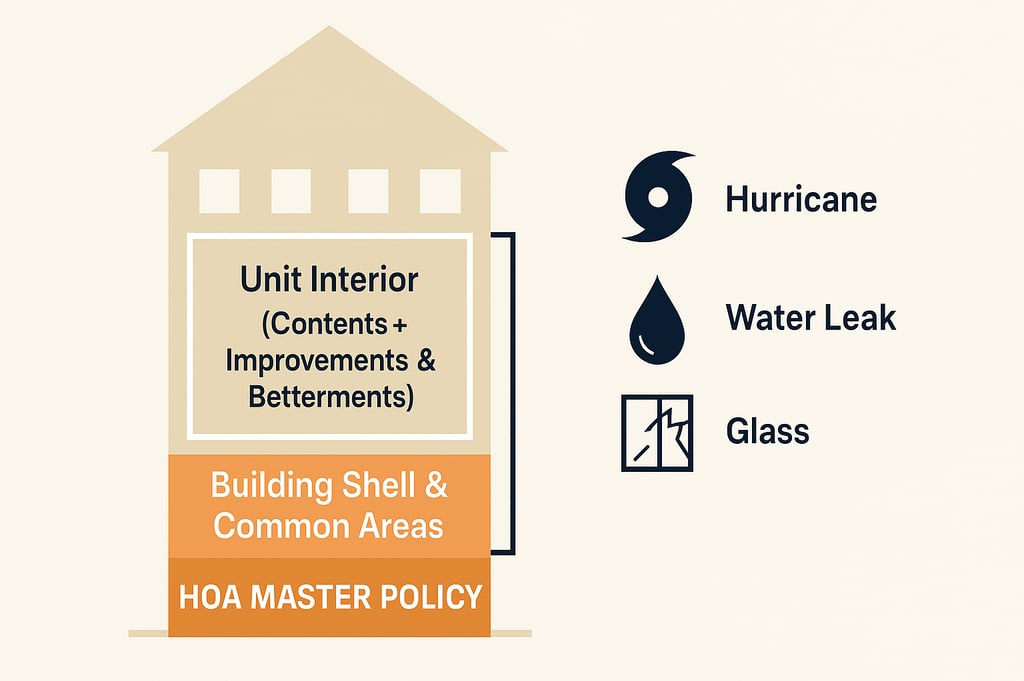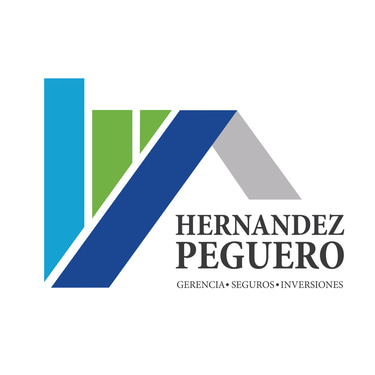FOR INFORMATION ON INSURANCE SOLUTIONS CALL OR WHATSAPP +1 849-514-9838 | info@hernandezpeguero.com
What Your HOA Covers—and What You Must Insure in Your DR Condo
Own a condo in the Dominican Republic? Learn what your HOA master policy covers, what your unit policy must include (contents & improvements), how deductibles work, and the add-ons condo owners actually use.
HernandezPeguero.com
10/1/20256 min read


Condo Master Policy vs. Unit-Owner Insurance in the Dominican Republic (What Your HOA Covers—and What It Doesn’t)
Buying a condo in the Dominican Republic is an exciting move—whether you’ll live year-round, visit seasonally, or host short-term rentals. But condo insurance can be confusing. The building has an HOA master policy, and you carry your own unit policy—so who covers what? This guide breaks down the division of responsibilities, the add-ons that matter in the DR, and how to coordinate claims when an incident affects multiple units or common elements.
What the HOA master policy usually covers
While every building’s bylaws and insurance wording differ, the master policy typically protects:
The building shell and common elements: structure, roof, exterior walls, elevators, hallways, lobbies, amenities, and shared mechanicals.
Common-area liability: when someone is injured in a lobby, pool deck, or hallway and the association is responsible.
Major catastrophes: windstorm/hurricane, fire, sometimes earthquake or flood (depending on the building’s choices and budget).
Master policies are designed to restore the common property and sometimes unit interiors to a basic “builder’s standard.” But they are not built for your personal belongings or custom upgrades—and they won’t always respond first when damage begins inside your four walls.
For a broad look at home and building protections in the DR, see our Property Insurance overview.
Where the master policy stops (and your responsibility starts)
Most condo owners need a unit policy that addresses these gaps:
Contents: furniture, electronics, décor, linens, appliances you own.
Improvements & betterments: anything beyond the original build spec—kitchen remodels, upgraded flooring, custom closets, high-end fixtures.
Unit-owner liability: if water from your unit damages a neighbor’s ceiling, or a guest is injured inside your apartment.
Loss of use / loss of income: if you must move out for repairs, or if you host short-term rentals and lose bookings due to a covered loss.
When selecting a policy type, compare Named Perils vs. All-Risks. In condo settings—where water leaks, power surges, and accidental damage are common—broader All-Risks wording can reduce surprises during claims. We explain the difference here: Named Perils vs. All-Risks Property Insurance.
DR-specific risks condo owners should model
1) Hurricanes & windstorm
From June to November, hurricanes and strong tropical systems can shatter glass, allow rain intrusion, or damage roofs and façades. Many policies apply a percentage deductible for windstorm losses. Example: If your contents are insured at US$60,000 and your hurricane deductible is 2%, you’d cover the first US$1,200 of a covered claim. Brush up with our plain-English guide to Understanding Deductibles in the DR and our seasonal primer Hurricane Season: What’s Covered.
2) Water damage (the condo classic)
Burst hoses, A/C drain clogs, or a neighbor’s leak can spot ceilings and destroy cabinetry. Clarify how your policy treats sudden and accidental water vs. long-term seepage, and whether master policy deductibles can be charged back to a unit when negligence is proven.
3) Glass breakage for sliders and balcony doors
Large glass surfaces are beautiful—and vulnerable. Many owners add a small-cost glass breakage rider. Learn more: Glass Breakage Insurance in the DR.
4) Power surges & electronics
Voltage fluctuations can fry A/C boards, routers, and TVs. Consider electronic equipment all-risk or equipment breakdown extensions. We summarize the most valuable extras here: Top Property Add-Ons.
5) Earthquake
Less frequent than windstorm but still relevant—especially for high-rise owners. See our explainer: Does Your Insurance Cover Earthquake Damage in Punta Cana?
Your unit policy: the essential building blocks
Contents & improvements/betterments
Inventory your belongings and estimate the cost to replace them new, today. For betterments, keep invoices for remodels and built-ins—these help establish value when you file a claim.
Personal liability (and optional umbrella)
If a guest slips on your wet tile, or your washer leaks into the unit below, personal liability responds up to your chosen limit. Owners of high-value units—or those who host frequently—often add a personal or commercial umbrella to increase overall protection.
Loss of use / loss of income
If a covered incident makes your condo uninhabitable, loss of use pays for temporary lodging. If you operate a short-term rental, ask for loss of income calculated on realistic occupancy and ADR—so peak-season weeks aren’t underinsured. (If you host, our companion guide to STR coverage is here: Airbnb & Short-Term Rental Insurance—and pairs perfectly with this post.)
Must-have add-ons for DR condos
Electronic equipment all-risk for TVs, routers, smart locks, and Wi-Fi gear used for hosting.
Equipment breakdown for A/C compressors and major appliances.
Glass breakage for sliding doors and balcony fronts.
Home Assistance (Asistencia en el Hogar) for lockouts, plumbing, and electrical emergencies—hugely helpful if you’re remote or your property manager is busy. See: Home Assistance Coverage Explained.
Theft extensions if your building’s base policy is limited on contents theft.
We break down these extras in Top Property Add-Ons.
Who pays? Quick real-world scenarios
Scenario A: Storm breaks your balcony glass
Master policy typically handles façade elements and common areas.
Your unit policy often responds for interior damage (furniture, electronics) and glass if the building’s policy or bylaws place balcony panes on the owner. A dedicated glass breakage rider removes doubt.
Scenario B: Leak from upstairs floods your bedroom
The upstairs neighbor’s policy may respond if negligence is proven.
Your unit policy should still be notified and can proceed without waiting for the neighbor’s insurer—protecting timelines for mitigation and restoration.
Scenario C: Water line inside your unit bursts
Your unit policy: repairs to damaged finishes and contents; liability if neighbors are affected.
Master policy: building elements like risers or common pipes (depending on bylaws).
Scenario D: Elevator room fire shuts the building for weeks
Master policy: building damage.
Your unit policy: loss of use or loss of income if you can’t occupy or host.
Coordinating a claim when multiple policies are involved
Protect & document immediately: stop the leak, board windows, and photograph everything—before cleanup.
Notify all parties: your insurer/broker, the HOA/administrator, and any affected neighbors.
Keep receipts and estimates: restoration, temporary housing, and replacement costs.
Align scopes: if the master policy repairs drywall “to primer,” your contractor’s estimate should clearly separate building vs. owner finishes.
Track rental calendars: for loss-of-income claims, keep booking confirmations, cancellations, and ADR history.
Follow a step-by-step process: our walkthrough How to File a Homeowners Claim in the DR includes timelines and documentation checklists.
Cost control without cutting key protections
Pick deductibles intentionally: higher deductibles lower premium, but keep enough liquidity to cover them. Review options here: DR Deductibles Guide.
Set realistic sums insured: update contents values annually—furniture and electronics inflate faster than you think.
Mitigate issues proactively: braided steel washer hoses, leak sensors under sinks, surge protectors for A/C and electronics.
Bundle where possible: insure multiple properties or combine with other lines for better pricing.
Pre-purchase checklist for condo buyers
Ask for the HOA insurance clause and certificate before closing.
Confirm whether balcony glass and interior betterments fall to the unit owner.
Verify windstorm deductibles (percentage vs. fixed) on both master and unit policies.
If you plan to host STRs, check HOA rules and ensure your policy allows short-term rental use.
Keep your broker’s WhatsApp handy for COI (certificate of insurance) requests.
Suggested external resources
Your HOA bylaws or declaration (“condominium regime”) for the building’s exact insurance responsibilities.
ONAMET (Oficina Nacional de Meteorología) for storm tracking during hurricane season.
A reputable insurance glossary for “improvements & betterments” definitions.
Internal resources you may also like
Property Insurance Overview — start here for coverages and quick quotes.
Hurricane Season: What’s Covered — windstorm examples and deductibles.
Named Perils vs. All-Risks — which policy form fits condo risks best.
Top Property Add-Ons — electronics, equipment breakdown, glass, home assistance.
How to File a Homeowners Claim — documentation and timelines.
Why Choose Hernández Peguero Insurance Brokers?
Condo owners need clarity at claim time—not fine print surprises. We specialize in Dominican condo portfolios, matching your building’s bylaws to the right carrier wording so coverage aligns with what your HOA actually requires. With us you get:
Tailored All-Risks or Named-Perils policies sized for contents and betterments.
Smart add-ons for condo realities: glass, electronics, equipment breakdown, home assistance.
Rapid certificates of insurance for HOAs and lenders.
Bilingual claims support that coordinates with administrators, neighbors, and adjusters to keep your timeline moving.
Explore options or start a quote here: Property Insurance.
Ready to Get a Quote?
Protect your Dominican Republic condo with the right coverage at the right price.
👉 Contact us now:
Phone / WhatsApp: +1 849-514-9838
Email: info@hernandezpeguero.com
Website: www.hernandezpeguero.com
We’ll guide you to the best plan for your condo so you can enjoy your home (and your bookings) with total peace of mind.
Hernandez Peguero
Your trusted partner for comprehensive insurance solutions.
Broker
Coverage
© 2024. All rights reserved.
